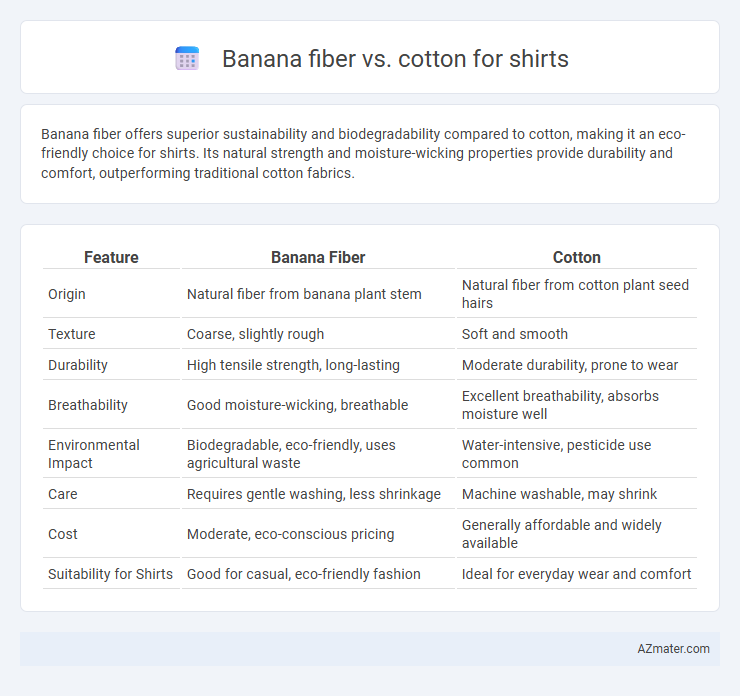Banana fiber offers superior sustainability and biodegradability compared to cotton, making it an eco-friendly choice for shirts. Its natural strength and moisture-wicking properties provide durability and comfort, outperforming traditional cotton fabrics.
Table of Comparison
| Feature | Banana Fiber | Cotton |
|---|---|---|
| Origin | Natural fiber from banana plant stem | Natural fiber from cotton plant seed hairs |
| Texture | Coarse, slightly rough | Soft and smooth |
| Durability | High tensile strength, long-lasting | Moderate durability, prone to wear |
| Breathability | Good moisture-wicking, breathable | Excellent breathability, absorbs moisture well |
| Environmental Impact | Biodegradable, eco-friendly, uses agricultural waste | Water-intensive, pesticide use common |
| Care | Requires gentle washing, less shrinkage | Machine washable, may shrink |
| Cost | Moderate, eco-conscious pricing | Generally affordable and widely available |
| Suitability for Shirts | Good for casual, eco-friendly fashion | Ideal for everyday wear and comfort |
Introduction: Understanding Banana Fiber and Cotton
Banana fiber is a sustainable natural textile derived from the pseudostem of banana plants, known for its strength, breathability, and eco-friendly properties. Cotton, a widely used natural fiber harvested from the seed hairs of cotton plants, offers softness, moisture absorption, and durability ideal for shirt fabric. Comparing banana fiber and cotton highlights differences in environmental impact, texture, and performance, influencing sustainable fashion choices.
Environmental Impact: Banana Fiber vs Cotton
Banana fiber production generates significantly less water pollution and greenhouse gas emissions compared to conventional cotton farming, which requires intensive water use and pesticides. Banana fibers are biodegradable and sourced from agricultural waste, reducing landfill waste and promoting circular economy practices. Cotton cultivation's heavy water consumption and pesticide dependency contribute to soil degradation and biodiversity loss, making banana fiber a more sustainable alternative for eco-friendly shirt production.
Production Process Comparison
Banana fiber production involves extracting fibers from the pseudostem of banana plants through a decortication process, followed by retting and drying, making it a sustainable alternative with minimal chemical use. Cotton production requires extensive cultivation, harvesting, ginning, and chemical treatments for fiber refinement, which often results in higher water consumption and environmental impact. The manual, eco-friendly methods used for banana fiber contrast sharply with the industrial, resource-intensive processes typical of cotton production.
Durability and Strength of Fabrics
Banana fiber exhibits superior durability and tensile strength compared to cotton, making it an excellent choice for long-lasting shirts that resist wear and tear. The natural cellulose content of banana fiber provides enhanced resistance to stretching and abrasion, while cotton's softness often compromises its structural integrity over time. Shirts made from banana fiber maintain their shape and firmness after repeated washes, outmatching cotton fabrics in strength retention.
Comfort and Breathability Factors
Banana fiber shirts offer superior breathability due to their natural porous structure, allowing better air circulation and moisture absorption compared to cotton. While cotton provides soft comfort, banana fiber excels in moisture-wicking, keeping the wearer cooler in hot and humid conditions. The durability of banana fiber also enhances long-term comfort by maintaining fabric integrity through repeated wear and washing.
Moisture Absorption and Odor Resistance
Banana fiber offers superior moisture absorption compared to cotton, making it ideal for shirts worn in hot and humid climates. Its natural antimicrobial properties enhance odor resistance, preventing the buildup of unpleasant smells during prolonged wear. Cotton, while breathable and comfortable, absorbs moisture but lacks the inherent odor-fighting benefits found in banana fiber.
Cost and Economic Considerations
Banana fiber shirts generally cost less to produce than cotton shirts due to the lower resource input and faster growth cycle of banana plants, making them economically efficient for sustainable fashion brands. Cotton production requires significant water, pesticides, and labor, increasing overall expenses and environmental impact. The emerging banana fiber market leverages agricultural waste, reducing raw material costs and offering competitive pricing with eco-conscious consumers driving demand.
Style, Texture, and Aesthetic Appeal
Banana fiber shirts offer a unique texture that is coarser than cotton but softens with wear, lending a natural, rustic aesthetic that appeals to eco-conscious fashion enthusiasts. Cotton shirts provide a smooth, breathable fabric with a classic, versatile style favored for everyday comfort and crisp tailoring. The distinct sheen and lightweight structure of banana fiber create an artisanal look, while cotton maintains timeless appeal with its uniform texture and diverse dye absorption.
Sustainability and Ethical Aspects
Banana fiber, derived from the pseudo-stem of banana plants, offers a highly sustainable alternative to conventional cotton by utilizing agricultural waste and requiring minimal water and pesticides. Cotton cultivation often involves intensive water usage and chemical inputs, raising concerns about environmental degradation and farmer health. Ethically, banana fiber supports small-scale farmers in tropical regions through fair trade practices, promoting social equity, while cotton production frequently faces challenges related to labor rights and exploitation in some areas.
Choosing the Right Fabric for Your Shirt
Banana fiber offers remarkable breathability and natural antimicrobial properties, making it an eco-friendly alternative to cotton that enhances comfort and durability for shirts. Cotton remains popular for its softness, moisture absorption, and ease of dyeing, providing versatile options in shirt design and wearability. Selecting between banana fiber and cotton depends on prioritizing sustainability and texture versus familiarity and wide availability in fabric choices for shirts.

Infographic: Banana fiber vs Cotton for Shirt
 azmater.com
azmater.com